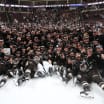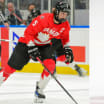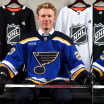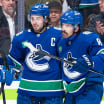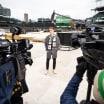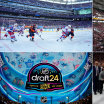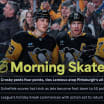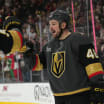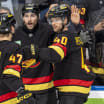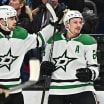Unmasked: Goalie rotations unlikely in Stanley Cup Playoffs
Necessary during grind of regular season but less so in postseason

© Jeff Bottari/Getty Images
The Boston Bruins have effectively used Linus Ullmark and Jeremy Swayman since Tuukka Rask retired on Feb. 9. The Washington Capitals have given Vitek Vanecek and Ilya Samsonov seven starts each during the past month.
Injuries and/or inconsistency have raised questions about who will play for the Florida Panthers, Toronto Maple Leafs, Carolina Hurricanes and Pittsburgh Penguins in the playoffs, and for the Los Angeles Kings, Dallas Stars and Vegas Golden Knights, should they qualify.
"I do think this year we may see more teams use two (goalies)," San Jose Sharks goaltending coach Evgeni Nabokov said. "The possibility is there because it's not one dominant guy. But it's really hard to do a split in the playoffs and not many times it happens by design because head coaches really only like one guy usually and if one guy gets hot, you just run with him."
The Minnesota Wild are the most likely team to use a back-and-forth split because they've mostly rotated goalies since acquiring Marc-Andre Fleury from the Chicago Blackhawks on March 21.
Since Fleury's debut March 26, the Wild alternated him and Cam Talbot for 14 straight games until Talbot played two in a row this week, starting against the Vancouver Canucks on Thursday after a 26-save shutout against the Montreal Canadiens on Tuesday. Fleury started the second half of a back-to-back Friday and made 25 saves in a 6-3 win against the Seattle Kraken.
The results of the split duties have been promising. While the two alternated starts, Fleury, 37, was 6-1-0 with a .921 save percentage, and Talbot, 34, was 4-0-3 with a .918 save percentage.
During the 2006-07 NHL season, Nabokov split starts with Vesa Toskala while playing for the Sharks. An injury to Toskala in mid-February made Nabokov the No. 1 throughout the playoffs.
Nabokov believes a familiarity with a goalie rotation during the regular season is necessary for the back-and-forth scenario to have any chance of working in the playoffs.
Corey Schwab agrees.
Schwab won the 1995 Calder Cup in the American Hockey League with the Albany River Rats, then the affiliate of the New Jersey Devils. That season, he rotated starts with Mike Dunham. Schwab and Dunham were named co-MVPs of the playoffs.
"The number one thing was Mike Dunham and I alternated games for the whole season, so going into the playoffs it was no different," said Schwab, who is the Arizona Coyotes goaltending coach. "But unless you spend the majority of the season going back and forth and both guys respond well to that type of scenario, I don't think a coach would do that."
In the right situation, there can be benefits to a goalie rotation.
While almost every goalie prefers the rhythm of playing every game, especially with few back-to-backs in the playoffs, a rotation allows a semblance of those timing elements. Teams don't have to worry about one goalie getting rusty after not playing for a prolonged stretch. And, as a goalie, knowing you're going back in regardless of what happens in the previous game removes the added mental pressure that comes with the win-and-stay-in philosophy adopted by most coaches.
Schwab cautioned that things must line up for a rotation to work. More time between games in the AHL playoffs were a factor in its effectiveness in Albany 27 years ago. So too was the tight defensive style of a good team.
Fleury may have the best chance to be part of a rotation this season, but he's also the best recent example of why it's unlikely.
Fleury alternated starts with Robin Lehner for the final 24 games with the Golden Knights last season. Each played extremely well; Lehner was 8-3-1 with a .921 save percentage; Fleury was 9-3-0 with a .932 save percentage.
"You don't have to wait too long before you're in net," Fleury said last season when talking about the six weeks of rotating starts with Lehner in the regular season. "I play, get a little bit of rest, practice hard, cheer for 'Lenny' next game and then I can get back at it, so I think it's not too bad because we're playing so often."
Once the playoffs started, Fleury took control with a dominant performance through the first four games against the Wild in the first round.
"I don't see any reason a rotation can't work in the right situation but I still don't think we'll see it," Anaheim Ducks goaltending coach Sudarshan Maharaj said. "A lot of it has to do with old-school thinking and coaches wanting one goalie."
That makes sense for teams with a more definitive, clear-cut No. 1 like the Calgary Flames (Jacob Markstrom) , New York Rangers (Igor Shesterkin), Nashville Predators (Juuse Saros), Colorado Avalanche (Darcy Kuemper) or Tampa Bay Lightning, especially after Andrei Vasilevskiy played every minute of back-to-back Stanley Cup championship runs the past two seasons.
Jordan Binnington started all 26 games and had 16 wins when the St. Louis Blues won the Stanley Cup in 2019, but in the four seasons prior to that, things were trending toward needing two goalies to win the Cup.
Philipp Grubauer started the first two games for the Capitals before Braden Holtby took over on the way to the 2018 championship. Fleury and Matt Murray shared the net for the Penguins in 2017. Murray, Fleury and Jeff Zatkoff each started at some point during Pittsburgh's 2016 championship. Corey Crawford finished as the Chicago Blackhawks starter for the 2015 Stanley Cup run, but they may not have gotten out of the first round without three wins from Scott Darling.
There was a similar run from 2006 to 2008, with the Hurricanes, Ducks and Detroit Red Wings each using two goalies to win a championship.
So even if a true rotation isn't part of the plans for any team right now, there's a good chance some will need two goalies in the playoffs.



